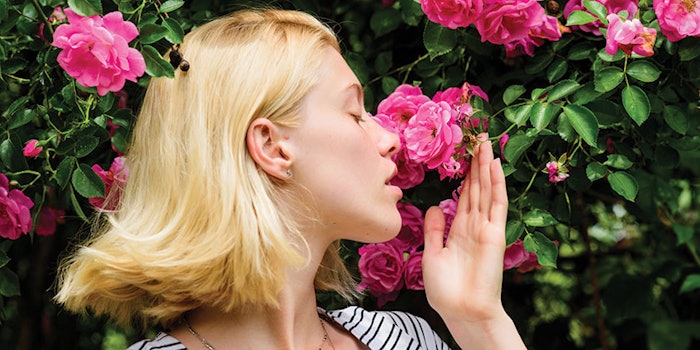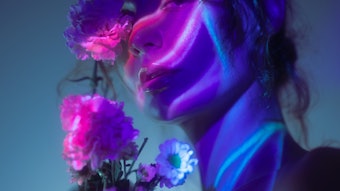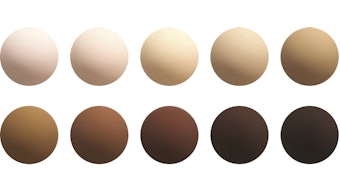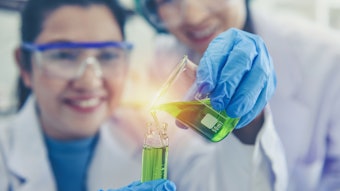
Read this article in its entirety in the May 2020 digital edition. . .
Fragrances are natural or synthetic essential oils or aroma compounds used in a wide variety of products to impart a pleasant odor, to mask the inherent smell of some ingredients, and to enhance the experience of using the product. They impart important benefits that are ubiquitous, tangible and valued; e.g., solving important functional problems and satisfying valued emotional needs. Indeed, numerous studies confirm that fragrances enhance well-being and have a positive impact on the psyche.1-4
Fragrances also communicate complex ideas, creating mood; signalling cleanliness, freshness or softness; alleviating stress; enhancing well-being; and triggering allure and attraction. Indeed, fragrances have been enjoyed for thousands of years and contribute to one’s individuality, self-esteem and personal hygiene.
Consumer research indicates that fragrance is a key factor affecting the consumer’s preference for a given cosmetic or personal care product.5 This may be due to one’s sense of smell being directly connected to the brain’s limbic system, where memory and emotions are stored.6, 7
Oftentimes, as marketers well know, a particular fragrance becomes strongly associated with product identity and acceptability. Just think: how often have you opened and sniffed a product before making a purchase selection?
This article provides a back-to-the basics look at fragrance and how it can enhance cosmetics and personal care products; from a brief look at its history and chemistry, to safety considerations, fragrance language and cosmetic applications.
Brief History
The word perfume derives from the Latin perfumare, meaning "to smoke through." Ancient texts and archaeological excavations show the use of perfumes in some of the earliest human civilizations. Ancient people used readily available herbs and spices, such as almond, coriander, myrtle, conifer resin and bergamot, as well as flowers in perfumes.8, 9
In India, perfume and perfumery existed in the Indus civilization (3300-1300 B.C.). One of the earliest distillations of Ittar (attar), the Smell of Muhammad, was mentioned in the Hindu ayurvedic text Charaka Samhita and Sushruta Samhita.10, 11
Perfumery, as in the art of making perfumes, began in ancient Mesopotamia and Egypt, and was further refined by the Romans and Persians. The world's first-recorded chemist is considered a woman named Tapputi, a perfume maker mentioned in a cuneiform tablet from the 2nd millennium B.C. (2000-1001 B.C.) in Mesopotamia. Records indicate she distilled flowers, oil and calamus with other aromatics, then filtered and put them back into the still several times.12, 13
In 2004 and 2005, archaeologists uncovered what are believed to be the world's oldest surviving perfumes in Pyrgos, Cyprus, dating back more than 4,000 years.14, 15 These were discovered in an ancient perfumery—a 4,000 m2 (43,000 ft2) “factory” housing at least 60 stills, mixing bowls, funnels, and perfume bottles.
In the early 11th century, the Persian chemist Ibn Sina introduced the process of extracting oils from flowers by means of distillation, the procedure most commonly used today.16, 17 He first experimented using rose. Until his discovery, liquid perfumes consisted of mixtures of oil and crushed herbs or petals, which made a strong blend. Rose water was more delicate and immediately became popular. Both the raw ingredients and distillation technology significantly influenced later Western perfumery and scientific developments, particularly chemistry.
The art of perfumery was known in western Europe from 1221. Between the 16th and 17th centuries, perfumes were used primarily by the wealthy to mask body odors resulting from infrequent bathing and it was partly due to this patronage that the perfume industry developed.
In 1693, the Italian barber Giovanni Paolo Feminis created a perfume water called Aqua Admirabilis, today best known as eau de cologne.18, 19 By the 18th century, the Grasse region of France, Sicily and Calabria (in Italy) were growing aromatic plants to provide the growing perfume industry with raw materials. Even today, Italy and France remain the center of European perfume design and trade.
Modern perfumery began in the late 19th century with the commercial synthesis of aroma compounds such as vanillin or coumarin, which allowed for the composition of perfumes with smells previously unattainable solely from natural aromatics.20, 21
Fragrance Chemistry
The science of perfume and fragrance has advanced significantly over the years—from the original isolation of ingredients from plant and animal sources, to a sophisticated science that allows for the preparation of unique new materials, and sensitive methods for controlling both the composition and quality of fragrances; supercritical fluid extract, for example.22, 23 Fragrance creation combines an artistic vision with an understanding of fragrance material chemistries and their dynamics together; too detailed to explore in this brief review. Suffice it to say, fragrance chemistry is a highly specialized field, requiring knowledge of the various substances and how these substances interact to produce the perceived and desired odor. (For in-depth fragrance chemistry information, visit our sister brand, www.perfumerflavorist.com.)
Many factors must be considered when formulating a fragrance, including the strength of its smell, the compatibility of ingredients with one another, its stability to light and heat, and even its interaction with product packaging. It also is important to consider the properties of ingredients after they are applied to skin. Some fragrance ingredients evaporate rapidly, while others remain on the skin for longer periods. The interplay of these properties over time is important to achieve the desired final effect and yields an aesthetically pleasing product.
Safety and Regulation
Fragrance ingredients in cosmetics must meet the same requirements for safety as other cosmetic ingredients; namely, they must be safe for consumer use according to the labeled directions or as they are customarily used. This is a responsibility that fragrance manufacturers and companies implementing fragrances take seriously.
The safety of fragrance ingredients is assessed by a comprehensive program operated by the International Fragrance Association (IFRA).24 This program, in operation since 1973, includes a Code of Practice (the Code) that provides recommendations for good manufacturing practices and guidelines on fragrance ingredient safety assessment; including safety standards that limit or ban the usage of certain fragrance materials.
IFRA oversees the gathering of information for the safety of individual fragrance ingredients and reviews this information to determine their safety under expected conditions of product use. The conclusions of the IFRA safety review are published in the IFRA Code of Practice,25 which provides critical guidance to fragrance formulators and users to establish product safety.
IFRA publishes its information based on the findings of the Research Institute of Fragrance Materials (RIFM), which conducts a scientific review of fragrance ingredients.26 RIFM is a non-profit, scientific institute founded in 1966 for the purpose of generating and evaluating the safety data of fragrance ingredients. The group gathers and analyses scientific data, engages in testing and evaluation, distributes information, cooperates with official agencies and encourages uniform safety standards related to the use of fragrance ingredients.
In terms of disclosure on a product label, fragrance ingredients or blends added to a product are typically indicated by the term fragrance or parfum. Few if any fragrances specify the materials comprising them, as this information is highly guarded and proprietary. The lack of disclosure, however, means consumers are not fully aware of all the ingredients in a product, and this can be a concern to some users.
For this reason, the EU has outlined a list of 26 of the most common fragrance allergens whose names must appear on the label of products when they are present in amounts exceeding a certain threshold.27 This way, sensitive users can avoid using the product.
In relation, some fragrance materials have been flagged for potential reproductive and developmental toxicity, in addition to allergies and sensitivities. However, IFRA does not permit these materials at all in fragrance compositions.
Fragrance Language Primer
As stated, the precise formulae of commercial perfumes are kept secret. In fact, even if they were widely published, they would be dominated by such long and complex chemical names that they would be of little use for providing guidance to the general consumer; much less comprehensively describing the experience of a scent. Nonetheless, connoisseurs of fragrance are quite skilled at identifying and describing components and origins of scents; much like wine experts.
The most practical way to begin describing a fragrance is according to the notes of the scent or "family" to which it belongs, all of which affect the overall impression—from the first application to the last lingering hint of scent.
Fragrance families: For example, a traditional classification that emerged around 1900 comprised the following families:28 single floral, floral bouquet, amber or “Oriental,” woody, leather, chypre and fougère. Since 1945, thanks to advances in the technology of perfume creation, i.e., compound design and synthesis, and the natural development of styles and tastes, new categories have emerged to describe modern scents: bright floral, green, aquatic, oceanic or ozonic, citrus, fruity and gourmand, for example.
Furthermore, scents have been derived from new sources. Plant parts may now include bark, flowers and blossoms, fruits, leaves and twigs, roots, rhizomes and bulbs, seeds, wood, etc. Animal sources, although less popular today, have included musk, ambergris, castoreum, civet, hyraceum and honeycomb. Other natural sources may include lichens and seaweed.
. . .Read more in the May 2020 digital edition. . .
References
- Sowndhararajan, K. and Kim, S. (2016). Influence of fragrances on human psychophysiological activity: With special reference to human electroencephalographic response. https://www.ncbi.nlm.nih.gov/pmc/articles/PMC5198031/
- Cosmetics Info (2016). Fragrance. https://cosmeticsinfo.org/ingredient/fragrance
- Svoboda, E. (2008, Jan 1). Scents and sensibility. https://www.psychologytoday.com/us/articles/200801/scents-and-sensibility
- Van Toller, A. and Dodd, G.H. (1988). Perfumery. The psychology and biology of fragrance. https://link.springer.com/book/10.1007%2F978-94-009-1215-1
- Ibid Ref 2
- Hamer, A. (2018, Jan 31). Here's why smells trigger such vivid memories. https://curiosity.com/topics/heres-why-smells-trigger-such-vivid-memories-curiosity/
- Fifth Sense (2015). Psychology and smell. https://www.fifthsense.org.uk/psychology-and-smell/
- Pure Life Vision (2020). Perfumes and fragrances. https://www.purelifevision.com/pages/articles/perfumes-and-fragrances.html
- History of Perfume (2020). http://www.historyofperfume.net/
- Attar Mist Ltd. (2020). What is attar? http://www.attarmist.co.uk/what-is-attar/
- Wikipedia (2019, Nov 19). History of perfume. https://en.wikipedia.org/wiki/History_of_perfume
- Flatley, H. (2018, Oct 29). The first chemist in history was a woman. https://www.thevintagenews.com/2018/10/29/tapputi/
- Helmenstine, H. (2017, Dec 27). Who was the first chemist? A woman named Tapputi. https://sciencenotes.org/who-was-the-first-chemist/
- Theme, R. (2017, Feb 8). Straight from Paris. https://demo.rarathemes.com/fluid-magazine/2017/02/08/straight-from-paris/
- NILOOFAA (2016, Nov 2). Perfume. http://niloofaa.com/en-US/info.aspx
- Power, J. (2014, Jun 12). Steam distillation of essential oils. https://artisanaromatics.com/steam-distillation-essential-oils/
- Seth, R. (2019, Sep 19). Fragrance—Important part of world history. https://incensemedia.in/stories/fragrance-important-part-of-world-history/
- Parfums Erru. (Accessed 2020, Apr 1). A short history of perfume. http://parfums.erru.world/a-short-history-of-perfume/
- Course Hero. (2020). A Byzantine alembic used to distill perfumes. https://www.coursehero.com/file/p7p384o8/A-Byzantine-alembic-used-to-distill-perfumes-The-Persian-chemist-Ibn-Sina-also/
- Arunpriya, S. and Shanthini Devi, M. (2013, Sep). A study on users' satisfaction of Axe brand (perfumes & deodorants) in Coimbatore city. https://www.worldwidejournals.com/indian-journal-of-applied-research-(IJAR)/article/a-study-on-users-satisfaction-of-axe-brand-perfumes-and-deodorants-in-coimbatore-city/MjIxMg==/?is=1&b1=49&k=13
- Alexander Perfumery. (2016). Products. http://www.alexanderperfumery.com/product.html
- Maurya, V.K. (Accessed 2020, Apr 1). Introduction to fragrances, flavors, ingredients and production. Presentation. http://www.ffdcindia.org/pdf/chemical_21may2014.pdf
- Serras, L. (2019, Apr 26). How is perfume made? The perfume manufacturing guide. https://www.fragrancex.com/blog/how-is-perfume-made/
- Vey, M. (2006, Jan). The International Fragrance Association: Role and responsibility in ensuring the safe use of fragrance ingredients. https://www.researchgate.net/publication/293519263_The_International_Fragrance_Association_Role_and_responsibility_in_ensuring_the_safe_use_of_fragrance_ingredients
- IFRA (Accessed 2020, Apr 1). IFRA code of practice—Our commitment to safe use. https://ifrafragrance.org/safe-use/code-of-practice-new
- RIFM. (2020). About RIFM. https://www.rifm.org/
- Eco Mundo. (2016, May 24). Allergens in cosmetic products: What are the requirements for the European market? https://www.ecomundo.eu/en/blog/cosmetics-allergens-europe-compliance
- Bespoke Unit (Accessed 2020, Apr 1). What are olfactive families and fragrance wheels? A guide to identifying perfumes. https://bespokeunit.com/fragrance/families/











